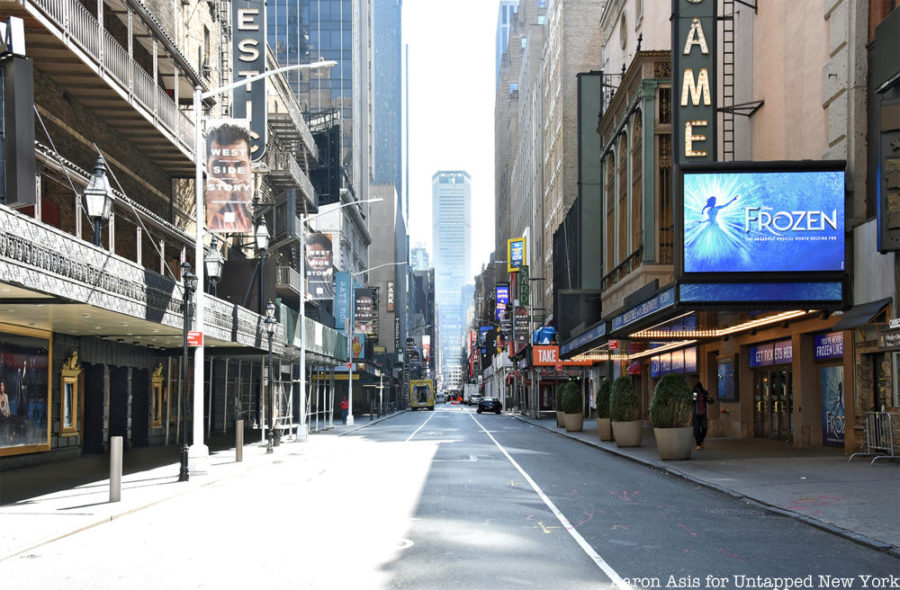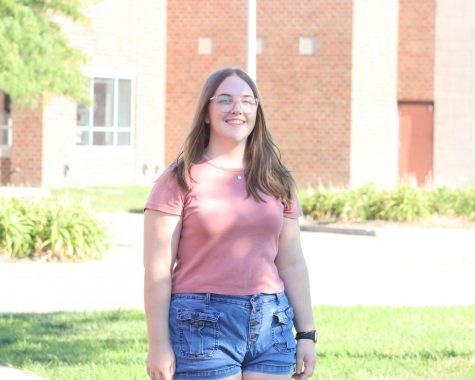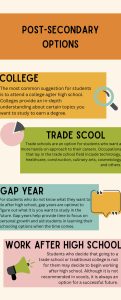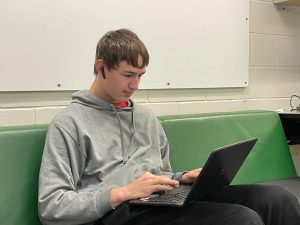When the curtains fell
The live theater industry’s pandemic struggles reveal how little we value the arts
photo courtesy of Untapped Cites
New York City’s Broadway, usually buzzing with tourists, artists and activity, remains lifeless during the pandemic.
May 20, 2021
With the COVID crisis looming over New York City, Broadway was shut down on March 12, 2020. Once-brimming auditoriums went silent. In some of the biggest theaters, like Gershwin Theatre, which houses over 1900 people, the seats were empty. Actors, directors, costume designers, makeup artists and stagehands packed their bags and hoped to return in a few weeks. Broadway, a booming tourist attraction and artistic center, went dark.
The Great White Way planned to come back a month later on April 12. Then, the reopening date was pushed to June 7, and again to Sep. 6, and again to Jan. 3, and again to May 30. Now, after a year and a half, Broadway has a return date they hope will stick: Sep. 14, 2021. Tickets went on sale this month, and theatres are allowed to book for full capacity.
The fall opening date makes New York City’s theater district one of the last places to reopen. Unlike other industries, live theatre has had few, if any, options to continue operating during the pandemic. While movies can be released on streaming services instead of in theatres, restaurants can deliver take-out and sports can be live-streamed to limit in-person attendance, the live theatre experience depends on large, in-person audiences. Because of the small, cramped layout of Broadway’s theatres, along with the fact that shows need to book all their seats in order to be profitable, social distancing has not been an option. Further, the majority of Broadway’s audience comes from out of town or overseas, which means pandemic travel restrictions kept away most of its customer base.
Because of these unique characteristics, the live theatre industry took a massive hit during the pandemic. Some shows, including Frozen and Mean Girls, announced that they will not be returning. Beyond that, theatre provides a source of emotional comfort and a sense of community for both artists and audiences during times of crisis. The pandemic closures took that away when it was needed most.
The real victims of the shutdown are the performers, costume makers, dancers, directors, set designers, makeup artists, and more who depend on theatre for their livelihood. Actors Equity, the actors’ labor union, represents over 50,000 people. Without work, many of those people were unable to meet the working requirements for getting healthcare coverage through Actor’s Equity. Performers and artists, with an unemployment rate of over 50% at the end of 2020, struggled to pay rent or buy groceries. With widely available vaccines and a new reopening date, artists who plan on returning to Broadway have a renewed hope, but with the back-and-forth of Broadway’s reopening dates for the past year, uncertainty lingers.
The lack of support from the government and donors hasn’t helped. Actors Equity has spent the past year and a half pushing relentlessly for Congressional aid for artists and entertainers. With reluctance, Congress met their demands of extended unemployment and, just two months ago, (after a full year in lockdown) passed full COBRA subsidies to help those without healthcare. However, government support for the entertainment industry during the pandemic has been slow and uneven. Usually, the arts, particularly theatre, depend on private funding, but donations to North American art organizations decreased by 14% last year.
Broadway’s pandemic struggles are about so much more than just one street in New York City. Touring shows, local theatres and off-Broadway shows have been impacted just as much. Omaha’s own Rose Theater had to cut its 2020-2021 season down to five shows from its typical nine. Additionally, Broadway contributes almost 15 billion dollars a year to the local economy in New York City. The shutdown impacted not just the theatres, but the nearby restaurants, hotels, stores and tourist attractions who depend on the patronage of the Broadway audience.
Each day that the live theatre industry remains closed is another day that performers, artists, audiences and local economies suffer. It is especially painful to watch given that sports arenas have already started filling back up. With the lack of government and social support for the arts during the pandemic, it’s clear where our priorities lie; despite the cultural and financial benefits it brings, America does not value the arts.
The arts vs sports dilemma is not new to the pandemic. In high school, arts have long been underfunded, and they are often among the first programs to go during rounds of school budget cuts. Socially, we applaud high schoolers who go on to play sports in college and express a desire to go pro, but if a student says they want to be an actor or a singer or a dancer, the response is often “why don’t you get a real job?” or “how are you going to make money?”
In a country that has historically undervalued the arts, there is a lot of uncertainty regarding what exactly a return to normalcy will look like for Broadway and for the arts at large. As our country decides what we want the “new normal” to look like going forward, what role do we want the arts to play? Do we want to value them more after a year without concerts, performances and plays? Do we want to fund arts programs and stop discouraging kids who express interest in art careers? Are we finally ready to see the value that the arts bring to our economy and culture, or are we going to continue pushing them aside in favor of sports?







